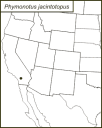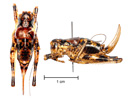




|

|

|

|
| map | male | female | male |

|
|||
| female |
| Song: | Single pulses with intervals of 0.8-1.0 seconds between pulses (23-25°C) in the laboratory. |
| Identification: | Robust body, males 13.7-18.2 mm in length, females 13.5-20.9 mm in length. Dome-shaped metazona. |
| Similar species: |
Phymonotus is similar to species in the genera Aglaothorax and Neduba. The following characteristics can be used to distinguish Phymonotus from these genera.
Males and females Number of lateral lobes on each side of the pronotum: Phymonotus, two. Aglaothorax and Neduba, one. Dorsal shape and posterior margin of metazona: Phymonotus, dome-shaped with concave posterior margin. Aglaothorax and Neduba, flat with acute posterior margin. Males Titillator: Phymonotus, base not sclerotized, dorsal sclerite present, and ventral sclerite absent with no teeth on ventral lobe. Aglaothorax, base sclerotized, dorsal sclerite absent, and ventral sclerite absent but with teeth present on ventral lobe. Neduba, base sclerotized, dorsal sclerite absent, and ventral sclerite present. Calling song: Phymonotus, single pulses with long intervals. Aglaothorax, single pulses with short intervals. Neduba, continuous with several pulse types. |
| Range: | Known only from the San Jacinto Mountains, Riverside County, California. |
| Habitat: | Mixed-conifer forests with Jeffery and ponderosa pine, white fir, and incense cedar. P. jacintotopos is closely associated with Jeffery and ponderosa pines and has body coloration that provides camouflage on these trees. |
| Life cycle: | One generation per year. |
| Season: | Adults: August through January. Males have been collected in early January when temperatures were near freezing and there was snow was on the ground. |
| Name Derivation: | Genus name, Greek: phymo (swollen) and notum, in reference to the enlarged, dome-shaped pronotum. Species name: jacinto, Spanish name of the San Jacinto Mountains, and Greek topos for place, in reference to the only known location where this species is found. |
| Remarks: | Phymonotus is in the tribe Nedubini, which has a geographic distribution that indicates Gondwanan ancestry. North America was not a part of Gondwana and therefore Phymonotus, and the other two Nedubini genera in North America (Aglaothorax and Neduba), are not directly descended from Gondwana. It is likely these three genera migrated from South America to North America. |
| References: | Lightfoot et al. 2011. |
| Nomenclature: | OSF (Orthoptera Species File Online). |

|

|